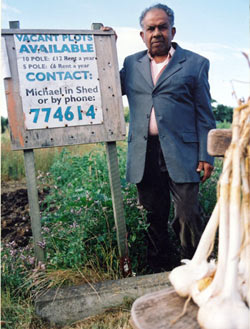The
Portuguese word saudade is untranslatable in English. It
evokes an aching sense of longing and homesickness, a yearning
for something lost and unobtainable.
Growing
up in England, I saw saudade in my mother Rosa Visitacão
Da Costa Fernandes' brown eyes when she spoke of "minha
terra" (my land), the "Perola do Oriente"
(Pearl of the Orient), and "Goa Dourada" (Golden
Goa).
A
native of Goa, India, my mother immigrated from her small
village of Nuvem to Kampala, Uganda, in 1961 after she married
my father, Manuel Rosario Fernandes, a British government
civil servant.
Eleven
years later, my family became refugees and fled to the cold
concrete and constant drizzle of England. But that seeping
sense of saudade always haunted my mother.
Her mantra was: "Quem viu Goa escusa de ver Lisboa"
(Whoever has seen Goa need not see Lisbon). We never went
on bucket-and-spade holidays to the seaside like my English
friends' families. Instead, my mother scrimped and saved
and planned the "great family holiday" —
a pilgrimage to Goa.
While
a middle school student, I went with my mother and younger
brother to Goa. I remember dancing in the monsoon rains,
counting mosquito bites and being chased by a cow around
my grandmother's garden. I was too young to comprehend my
surroundings, and Goa did not pique my interest.
But
after living away from my family in the United States for
eight years, I began to experience a seeping sense of saudade:
Who am I? Where am I from? Why can't anyone pronounce my
Portuguese name?
When
I asked my mother to go with me to Goa, she was shocked.
With a little coaxing, however, she soon agreed. We traveled
in January, when the crowds thinned out and the weather
was cooler.
Flying
into Dabolim Airport in Goa, I realized I was entering a
special part of the world. Jutting out from a remote section
of the Arabian Sea, the airport was nestled amidst rugged
cliffs, sandy beaches and lush green coconut groves.
Tucked
between the hills of the Western Ghats ad the Arabia Sea,
Goa spans 1,350 square miles and is about halfway down the
West Coast of the Indian peninsula.
Covered
with verdant hills and wooded with jackfruit, mango and
cashew groves, it is crisscrossed by rivers and edged with
60 miles of unspoiled beaches with sand like muscovado sugar.
Getting
off the plane, I was buffeted by a stream of cool air off
the sea. My mother looked happier than I had seen her in
years, speaking Konkani (the Goan language) and trying to
find a taxi to take us to her village.
After
several unsuccessful tries, we found a driver, Octavio,
with a 1950s yellow and black Morris Oxford, who was willing
to takes us to Southern Goa.
Sitting
in the taxi and watching tiny villages flash by was like
going back in time. We passed roadside shacks selling sugar
cane juice or watermelon. The pace of life seemed so slow.
"Sossegado,"
my mother explained authoritatively. In Portuguese, it means
calmness and quiet. To a Goan, the expression encapsulates
a way of life that is relaxed and full of joy.
Suddenly,
our driver braked and we lurched forward. A goat was crossing
the road.
Since
Goa's absorption into the Indian Union in 1961, there have
been many changes. But you can still drive through bucolic
towns with Iberian-style villas and stop at a small taverna
(bar) for a drink of feni (a potent local brew made from
the juice of distilled cashew nuts.)
Vasco
da Gama, a Portuguese sea captain, first landed south of
Goa on the Malabar Coast in 1498. Seeking Christians and
spices, he was the first European to reach India.
Afonso
de Albuquerque consolidated the network of outposts that
da Gama had captured, laying the foundation for Portugal's
maritime empire, including Daman and Diu. In the 1600s,
everything from gold and spices was traded in Goa's ports.
Until
Dec. 19, 1961, Goa remained a Portuguese colony. In 1962,
Goa, Daman and Diu were integrated with the Indian Union.
Splitting from the other two colonies in May 1987, Goa became
the 25th state of the Indian Union.
But
Goa has retained a distinctive Portuguese flavor. With their
red-tiled roofs and narrow streets, villages have a Mediterranean
feel. The last stop on a bus is usually hailed by the driver
shouting "praça," which means "village
square" in Portuguese.
The
countryside is dotted with whitewashed churches and restaurants
selling Portuguese-style food such as caranguejo recheado
(stuffed crab), caldeirada (fish stew), and rissois (rissoles
made from shrimp).
Our
first stop was Old Goa, the capital of the 16th century
Portuguese colony and a principal city in the Portuguese
Eastern Empire. Compared to Lisbon in its magnificence,
Old Goa evokes Old World charm with its collection of churches
and cathedrals.
Completed
in 1605, Bom Jesus Basilica houses a silver sarcophagus
with a glass coffin where St. Francis Xavier's mummified
corpse is kept. On the walls surrounding it are murals depicting
scenes from the saint's journeys. The annual feast of St.
Francis is held Dec. 3.
Architecturally,
Sé Cathedral (St. Catherine's Cathedral) is Portuguese-Gothic
with a sprawling Baroque facade. Built in 1533, it has an
intricately carved gilt altar, 15 exquisite chapels and
is the largest Christian church in Asia.
On
the northern part of Old Goa, Viceroy's Arch was built as
the official gateway to all the viceroys dispatched by the
Portuguese government. Facing the Mandovi River, it features
a statue of explorer Afonso de Albuquerque in the niche
above the entrance. Like all tourists, we had our picture
taken there.
After
overdosing on the opulence of Goa's Portuguese architecture,
I needed to get in tune with my inner mall and help bail
out my mother's homeland from the clutches of the World
Bank. I went shopping.
Meanwhile,
my mother held court on the balcony of my grandmother's
house. Traditionally, neighbors visit each other in the
late afternoon, sipping cold Limca and eating jackfruit
and guavas.
The
nearest town was Margão, the second largest in Goa
and the provincial capital of Salcette.
Wandering
through the labyrinth-like covered market, I gasped at 3-foot
mountains of chilies in market stalls and the array of brightly
colored sweets.
For
more of an adventure, you should venture north to Mapusa
Bazaar and the Anjuna Flea Market.
With
my uncle, I took the bus to Panjim, the capital, and changed
buses for Mapusa in the north region of Goa. Every Friday,
there is a bustling market or bazaar. Everything from mendhi
tattoos to mirrorwork cushions are available for a few dollars.
It
draws hordes of Goans and tourists vying for everything
from fresh papayas to silver trinkets.
For
the ultimate tourist shopping experience, you have to go
even further north to Anjuna for the Wednesday flea market.
Having
exasperated one uncle with my desire to buy needless trinkets,
my other uncle accompanied me on the journey that took three
buses to reach the far flung northern corner of Goa.
For
a colony of hippies living in Anjuna, the market is a rite
of passage. Imagine San Francisco's eclectic Haight-Asbury
section, and Anjuna has an equally eclectic collection of
hippies, artists, aura diviners and yoga fanatics touting
their wares.
Compared
to Mapusa Bazaar, the market is expensive, but some items,
like papier-mâché boxes from Kashmir in Northern
India, are extremely inexpensive.
Drained
from shopping, we went to one of the many beaches tucked
along the province's coastline.
To
avoid tourists, we went to Palolem beach in Canacona, a
rocky district in the south that harbors sprawling desolate
beaches.
Sitting
on the beach flanked by palm trees, I thought about how
brave my mother was to have left her tiny village and this
Eden in search of a better life.
The
search for saudade had led me back to my mother, Goa and
myself. |







